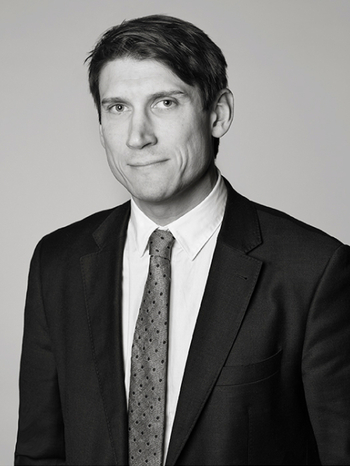Sven X:et Erixson
"Runforskaren" (Runologist)
Signed Sven Erixson. Executed 1949. Canvas 111 x 89 cm.
Provenance
Färg och Form, Stockholm, Sweden.
Acquired from the above.
Exhibitions
Färg och Form, Stockholm, Exhibition No. 1, 31 January - 17 February 1953.
Liljevalchs Konsthall, Stockholm, "Sven X:et Erixson", 20 September - 30 November 2003.
Literature
Lars-Erik Åström (editor), "Sven Erixsons konst", SAK 1967, illustrated page 156.
Thomas Millroth, "Konst på Astra", 1997, illustrated full page, p 33.
"X:et sällskapets verkkatalog", listed under the year 1949.
More information
Sven Erixsons målning "Runforskaren" som konstnären målade 1949 är berömd. På bilden ses professor Sven B.F. Jansson, kallad "Run-Janne", när han på 1940-talet är i full färd med att fylla i runskriften med rödfärg för att göra texten på den så kallade Holmfastristningen i Södertälje läsbar igen. Jansson var proffesor i runologi vid Stockholms universitet 1955-66 samt riksantikvarie 1966-72. Ristningen som han arbetar på i målningen är daterad till 1050-1080 e.Kr. och runmästaren som utförde den hette Östen. I ristningen ingår ett kors, vilket ger oss information att Holmfasts släkt var kristen. I övrigt är stenhällen omtalad för sin vackra utsmyckning med ett sirligt djur. Stenhällen är belägen vid den forna "Holmfasts väg" som ledde från Tälje till Näsby vid sjön Måsnaren. Runstenar var statussymboler och skulle ses av många förbipasserande, det är därför troligt att Holmfasts väg var en del i ett större vägsystem. Mycket tyder på att föregångaren till Göta landsväg gick förbi här, den äldsta och enda vägförbindelsen från Stockholm via Södertälje söderut mot Östergötland
Med på Sven Erixsons målning finns också "Run-Jannes" hustru, som vid tillfället var gravid med dottern Gunnel. Gossen i förgrunden med röd mössa är troligen konstnärens son Sverre som ofta förekommer i Erixsons konst.
Designer
Sven Erixson, today more commenly known as X, was born in 1899 in Stockholm. He studied to become a decoration painter and art teacher at the Technical School in Stockholm after which he studied at the Higher School of Art and Design alongside study trips to Germany, France, Italy, Spain and North Africa. Despite being an inportant artist amoungst Swedish art, Erixson does not let etiquette and style limit his painting style. His greatest creation is defined by a tempremental style in stark colour patterns. Erixson's paintings balances between impressive, somewhat brutal expressions and a soft lyricism. He is one of the founders of the group Färg och Form, whose primitivist faction he belonged to. With an aura of narrative joy, Erixson recounts his experiences. He had an irresistable desire to share everything that he saw. He was inspired, much like Bror Hjorth of both folk art and mural painting from the middle ages, while also finding inspiration from German expressionism. But he speaks with greatest esteem about Chaim Soutines art. In a multitude of paintings, he conveyed his zest for life, with surfaces filled with swiftly captured figures. During the 1930s, his visual world was filled with family and the idyllic torpor, his canvas became greater and more complete. During the war he painted on butter paper, not only for practicalities sake, but also to take advantage of the slippery reflective surface which the paper supplies. Narration decreased in the 1950s when he was influenced by spontaneity, which in the following years led him to abstract spontaneous painting.
Read more






























